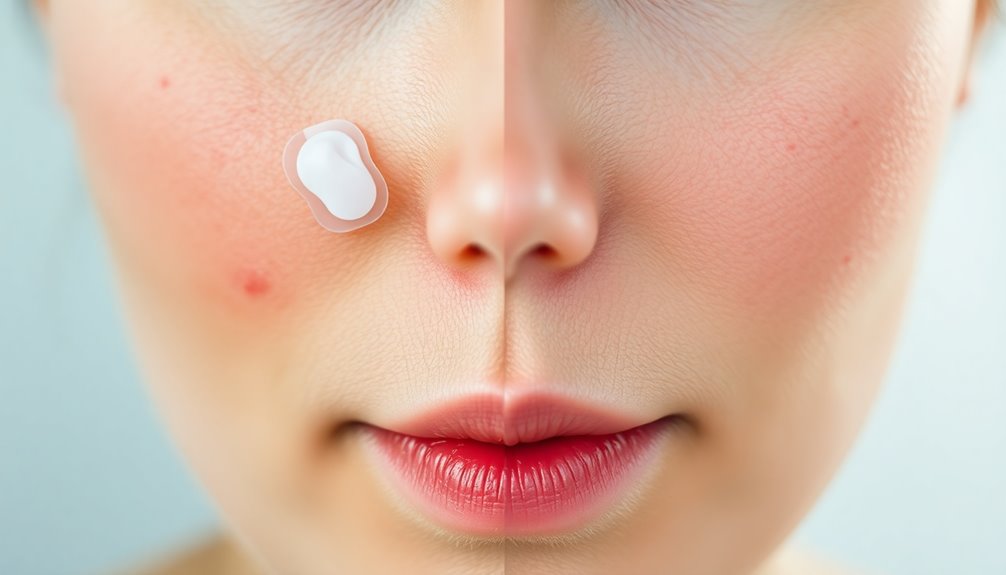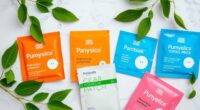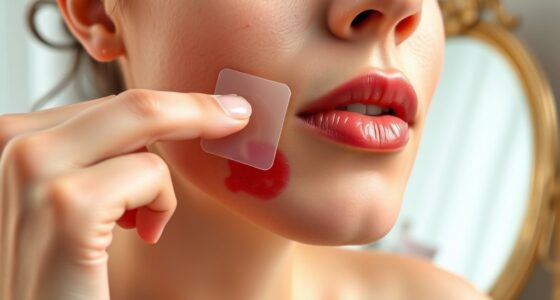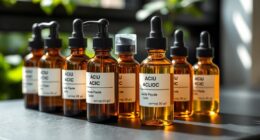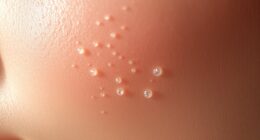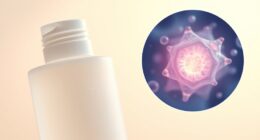When you use a pimple patch, you can expect it to considerably reduce blemishes overnight. The patch absorbs excess fluids and creates a protective barrier, helping to flatten pimples and speed up healing. You might see visible improvements in inflammation and size by morning. For best results, apply the patch on clean, dry skin and leave it on overnight. Want to know more about how to maximize your results and incorporate them into your routine?
Key Takeaways
- Pimple patches absorb excess fluids, reducing the size and inflammation of surface-level acne within hours of application.
- Expect a visible reduction in redness and swelling after leaving the patch on overnight or for several hours.
- Some users notice a significant improvement in the appearance of pimples, while deeper cystic acne may require additional treatments.
- Regular use of patches can help prevent future breakouts by maintaining skin hydration and reducing the urge to pick at blemishes.
- Monitor your skin for any irritation or allergic reactions, adjusting usage as needed for best results.
Understanding Pimple Patches
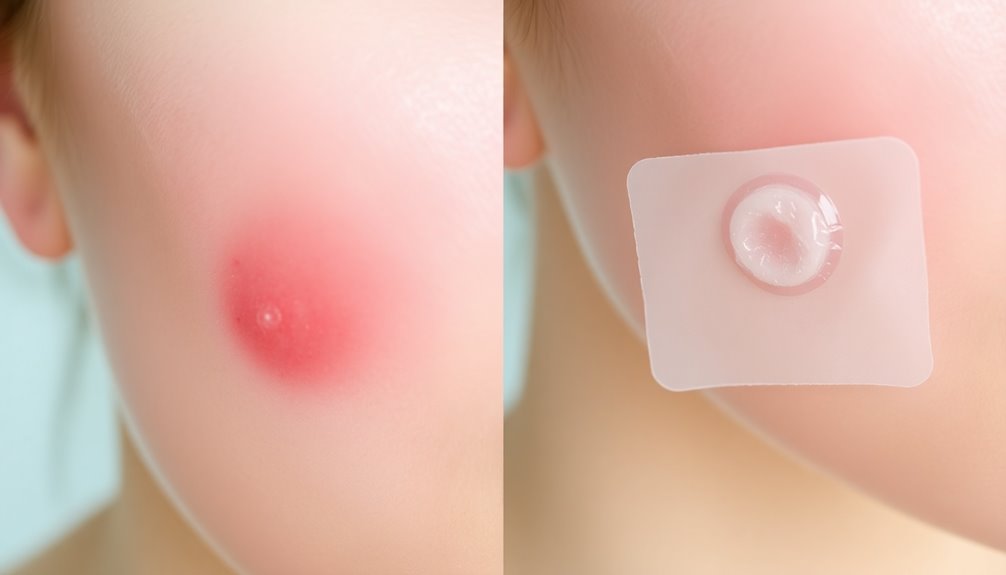
Have you ever wondered how pimple patches work their magic? These little wonders are made from hydrocolloid, a material known for its ability to absorb fluid, making it perfect for treating pimples. They come in various types, including those infused with salicylic acid or tea tree oil, each offering unique benefits. Pimple patches reduce inflammation and protect your skin from external bacteria, acting as a barrier to prevent you from picking at your blemishes. They are designed to be discreet, often translucent or skin-toned, allowing you to wear them confidently, even under makeup. Thicker patches provide more protection and active ingredients at night, making them an ideal choice for overnight treatment. Additionally, these patches often contain salicylic acid to further enhance their effectiveness. Simply apply one directly to a pimple, and let it work its magic while you go about your day or night.
How Pimple Patches Work
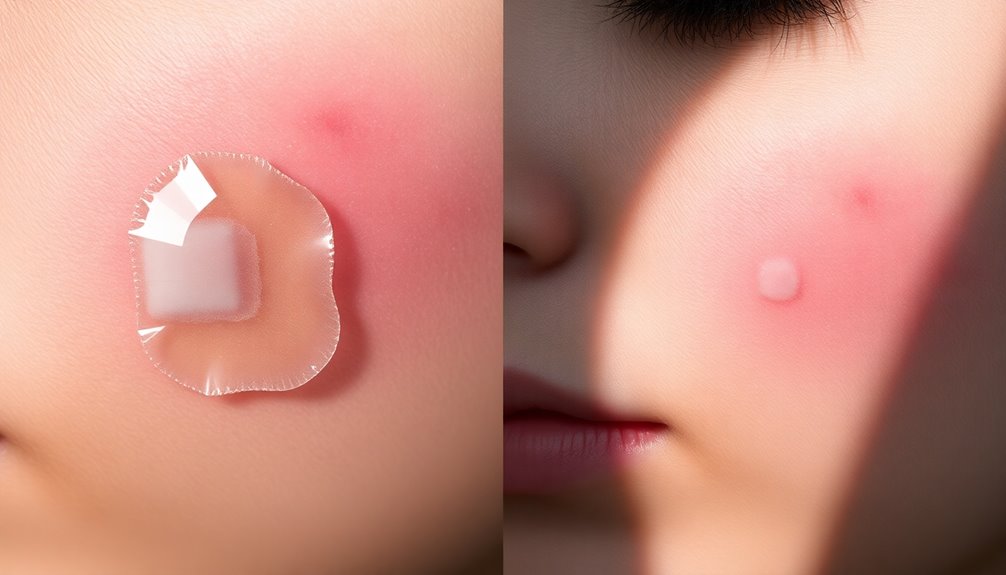
When you apply a pimple patch, it works by harnessing its hydrocolloid material to absorb excess fluids like oil and pus from the blemish. This absorption reduces inflammation and promotes faster healing. The patch creates a protective barrier that prevents bacteria and contaminants from entering the pimple, minimizing the risk of infection. By keeping the area moist, it fosters an ideal environment for healing. Additionally, some patches contain active ingredients like salicylic acid to further combat acne, which can enhance the effectiveness of the treatment. The patch discourages you from picking or scratching, which can lead to scarring.
Different Types of Pimple Patches

While exploring the various types of pimple patches, you'll find that each one is designed to target specific acne concerns effectively. Hydrocolloid patches absorb fluid and flatten pimples, while medicated patches contain salicylic acid or benzoyl peroxide to reduce inflammation. If you're dealing with cystic acne, microneedling patches deliver active ingredients deeper into the skin. Non-medicated patches are great for preventing picking and absorbing excess fluids from surface-level pimples. It's important to remember that papules can be painful, which makes choosing the right patch crucial for comfort and effective treatment. You'll also notice thicker patches are ideal for overnight use, while thinner ones work well during the day, blending seamlessly under makeup. Choose a patch that suits your specific acne type, and enjoy the benefits tailored to your skin's needs!
Effectiveness of Pimple Patches on Various Acne Types

Pimple patches work wonders on surface-level acne, like whiteheads and small pus-filled bumps, by reducing inflammation and absorbing excess oil. They create a protective barrier, preventing you from picking at your pimples, which can lead to scarring. Additionally, these patches are effective for pus-filled pimples, drawing out impurities while preventing infection and creating a moist environment that accelerates healing.
If you have sensitive skin, these patches offer gentle care without harsh chemicals. However, they're less effective for deeper cystic acne and blackheads. For mild acne, they can greatly reduce size and inflammation. While pimple patches provide immediate benefits, they don't address underlying causes or prevent future breakouts, so consider them as part of a broader skincare routine.
Proper Application and Removal Techniques

Before applying a pimple patch, make sure your skin is clean to maximize its effectiveness. Proper application techniques can enhance the patch's ability to absorb excess fluid and promote healing. After wearing the patch, gently remove it to avoid irritating your skin. This careful approach not only helps with healing but also prevents potential scarring.
Clean Skin First
To achieve the best results with your pimple patch, start by making certain your skin is clean and prepped for application.
First, cleanse your face thoroughly with a gentle cleanser to remove any dirt, oil, or makeup that could hinder the patch's effectiveness. Thorough cleansing of the face is crucial for effective pimple patch application.
Make sure your skin is completely dry before applying the patch, as moisture can prevent proper adhesion.
It's essential to apply the patch directly on the pimple without any other skincare products interfering.
Choose a patch that not only covers the pimple but also a small surrounding area.
Finally, press and hold the patch firmly for about 10-15 seconds to guarantee it sticks well, creating a clean environment for ideal healing.
Gentle Removal Process
While it's tempting to rip off a pimple patch in a hurry, taking a gentle approach is essential for maintaining your skin's health.
Start by washing your hands to prevent bacterial transfer. When you're ready to remove the patch, do so slowly and gently to avoid irritating your skin. After removal, cleanse the area with a mild cleanser to eliminate any residue. Don't forget to apply a gentle moisturizer to soothe your skin afterward, as gentle care is crucial for maintaining skin clarity. Reflect on how effective the patch was, which will help you improve future applications.
What to Expect: Before Applying a Pimple Patch
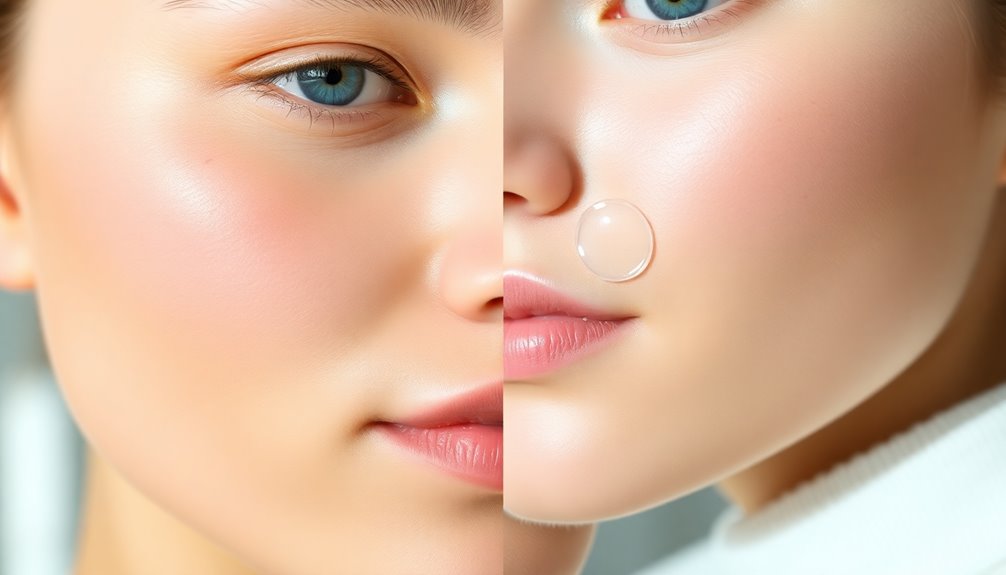
Wondering what you need to do before applying a pimple patch? Start by cleansing your skin with a gentle cleanser to remove dirt, oil, and makeup from the affected area. Once washed, make sure the skin is completely dry for better adhesion. Next, choose the right type of patch—whether it's hydrocolloid, medicated, or microneedle—based on the pimple's characteristics. Hydrocolloid patches are particularly effective for absorbing drainage from pimples and providing a protective barrier. Avoid applying the patch on irritated or sensitive skin, and if you use pre-treatment products like salicylic acid, apply those first.
Results After Using a Pimple Patch

After using a pimple patch, you'll likely notice a significant reduction in inflammation, leading to less redness and swelling around the affected area. These patches create a moist environment that accelerates healing, allowing your skin to recover faster. By acting as a barrier, they help prevent you from picking or popping pimples, reducing the risk of infection and scarring. Hydrocolloid patches are particularly effective, absorbing excess fluid from pimples and helping to flatten them. Plus, their convenience makes them easy to wear discreetly throughout the day. Additionally, the patches absorb fluid to create a moist healing environment, which is essential for faster recovery.
Safety and Precautions to Consider

When using pimple patches, it's crucial to take into account safety and precautions to guarantee the best results without causing irritation.
First, assess your skin sensitivity; patches may irritate or dry out sensitive skin, particularly those with active ingredients like salicylic acid. If you have adhesive allergies, steer clear of these patches to avoid skin issues. Hydrocolloid patches are designed specifically for acne use, so applying them only to open lesions after cleansing and drying your skin will ensure better adhesion. Most patches are designed for short-term use, so don't leave them on too long.
Monitor for any allergic reactions, like redness or itching. For deeper acne types, consider consulting a dermatologist, as pimple patches aren't a one-size-fits-all solution for every skin condition.
Incorporating Pimple Patches Into Your Skincare Routine

Incorporating pimple patches into your skincare routine can be a game-changer for managing breakouts effectively. To make the most of them, apply patches on clean, dry skin before your moisturizer. Leaving them on overnight allows for ideal healing while discouraging picking. Consistency is key; regular use helps prevent future breakouts. You can also combine patches with other products for all-encompassing care. Hydrocolloid patches help absorb excess fluid and speed up the healing process, making them an excellent addition to your regimen. Additionally, these patches create a protective barrier that shields your skin from bacteria and dirt, enhancing their effectiveness.
Here's a quick reference table to guide you:
| Step | Description |
|---|---|
| 1. Clean Skin | Start with a clean, dry face. |
| 2. Apply Before Moisturizer | Guarantee effective adhesion and absorption. |
| 3. Overnight Use | Maximize healing while you sleep. |
| 4. Consistency | Use regularly for best results. |
| 5. Combine Wisely | Pair with other treatments as needed. |
Frequently Asked Questions
Can I Use Makeup Over a Pimple Patch?
Yes, you can use makeup over a pimple patch!
Just make sure to choose the right patch designed for makeup compatibility. Apply your makeup gently to avoid disturbing the patch, and opt for a matte finish to reduce visibility.
Remember to avoid heavy application, as that might draw attention to the patch.
With the right techniques, you can protect your pimple while still achieving a flawless look!
How Long Should I Wait Between Patch Applications?
When it comes to patch applications, you'll want to strike while the iron's hot!
Typically, you should wait at least 4-8 hours before applying a new patch, especially if the previous one has absorbed oil and dirt.
If you're dealing with a stubborn pimple, it might be okay to leave it on longer, up to 24 hours.
Just remember to keep your skin clean and moisturized between applications for the best results!
Do Pimple Patches Expire?
Yes, pimple patches can expire.
Hydrocolloid patches generally remain effective for three to five years, but it's best to use them within this timeframe for ideal results.
If the patches contain active ingredients like salicylic acid or benzoyl peroxide, they do have expiration dates and can lose effectiveness over time.
Always check the packaging for those dates, and store them in a cool, dry place to maintain their quality.
Can I Reuse a Pimple Patch?
You might think reusing a pimple patch is just a little shortcut, but it's really not a great idea.
When you consider how they absorb bacteria and pus, you're risking infection and irritation. Plus, those used patches lose their effectiveness.
Instead, embrace the fresh, single-use patches designed for ideal healing and hygiene.
Trust me, your skin will thank you for keeping it clean and safe while tackling those pesky blemishes!
Will Pimple Patches Work on Non-Acne Blemishes?
Pimple patches typically aren't designed for non-acne blemishes like eczema or dermatitis.
They excel at treating surface-level pimples, absorbing excess fluid, and protecting against irritation.
If you're dealing with a different type of skin issue, you mightn't see the desired results.
It's best to consult a dermatologist for proper diagnosis and treatment tailored to your needs.
Conclusion
Incorporating pimple patches into your skincare routine can be a game-changer, much like finding a hidden gem in a cluttered treasure chest. You'll notice quicker healing and reduced inflammation when used correctly. Just remember to apply them on clean, dry skin and give them time to work their magic. With consistent use, you can say goodbye to pesky blemishes and hello to clearer skin. So, why not give pimple patches a try for that extra boost of confidence?
Claire has a knack for turning complex dermatological concepts into engaging, easy-to-understand articles. Her work primarily focuses on creating detailed reviews and thought-provoking articles in the “Vetted” category. Claire’s writing not only informs but also inspires our community to try new skincare solutions.
